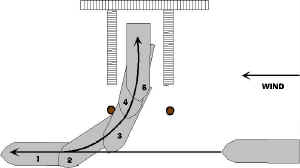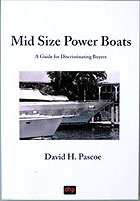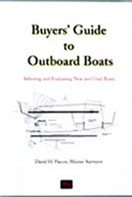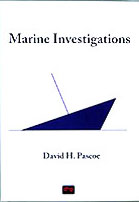Docking in Style
With Twin Screw Boats
by David Pascoe
The unfortunate thing about docking in crowded marinas is probably less a matter of the embarrassment of hitting some one else's boat, but that there are usually so many people around to see you do it!
We've all screwed up one time or another, so we know how embarrassing it is to be standing there, half panic-stricken at the controls of our boat (which is out of control) while a half dozen of your dock mates are all standing there trying to suppress a smirk. Or scrambling to protect their boats from the impending disaster.
- Stay Calm
- Take One Day for a Dedicated Practice Session
- Use Shifters and Throttles Only
- Hands Off the Wheel!
- Dancing
- Docking
- Angled Approach
- Winds and Tides
- Slip Docking
- Illust.#1 - Drive-in Approach
- Illust.#2 - Head-in Approach
- Illust.#3 - Backing into a slip approach
Stay Calm
The first thing to understand about docking situations is the need to stay calm and never engage in hasty control actions. That happens because basically you don't know what to do, but you just feel you have to do something.
Many people are too cautious, and try to maneuver the boat so slowly that the wind or tide catches the boat and they lose control anyway. Others move too fast, applying one over-reaction against another. Be aware that the ONLY way you can learn to maintain precise control, without over or under-reacting, is by learning to develop absolute control of your boat.
And the only way to do that is by taking the time to learn and practice. Far too may boat owners just won't bother, and that's why marinas on Saturday afternoon can be very entertaining just watching people inexpertly trying to dock their boats.
Take One Day for a Dedicated Practice Session
Like flying an airplane, expert boat handling takes both knowledge and some practice. Problem is, most newcomers to boating (that means someone who's been driving boats for 5 years or less) don't even use their boats often enough to even get the practice that they need.
If you don't like being embarrassed with a crowd looking on, the best way to resolve this is to just take one day -- maybe about 3-4 hours -- for a dedicated practice session.
Be aware that no one learns much in panic situations; you learn the most when the pressure is off. Most people have never done this, and you'll be amazed at how much your boat handling will improve by doing this. And after you've done this once, chances are that you'll be motivated to keep on practicing.
Most likely you occasionally lose control of your boat because you don't know how to handle it under all circumstances and conditions. I'm talking here about close quarters maneuvering as in docking, waiting for bridges in narrow waterways, things like that.
So let's start with two important facts: (1) any twin engine boat is capable of very precise control and, (2) all adverse conditions, like wind and tides, can be turned to your advantage. But first, let's make sure that you understand the basic principles of twin engine boat control.
Illustration #1
Click for bigger graphic.
The drive-in approach is most useful when you have plenty of space. Instead of trying to steer the boat into a docked position, ease the bow into the position shown above. Then use your engine controls to swing the stern in flush to the dock.
Use Shifters and Throttles Only
All idle speed handling is accomplished with the shifters and throttles, never the steering wheel. If you are attempting to use the wheel while docking STOP! The rudders are of little or no help at slow speeds.
Why? Because like an aircraft wing, if there is no air flowing over the wing, the plane won't fly. If there is no water flowing around the rudder, the boat won't steer, so there's no point in trying to steer your way into a dock. It won't work.
The first step in learning precision control is to become skilled at the use of throttles and shifters. You do that by finding the time and right place to practice. A good time is on a weekday when there is little traffic; a good place is something like a gas dock at the end of a T dock where you have lots of maneuvering room.
The objective here is to have a place near a large bulkhead dock where you can use the dock as a point of reference. All the while here you are going to be well away from the dock, but close enough that you use the dock as a gauge to how the boat is moving. Give yourself plenty of room that the dock isn't going to get in your way.
Hereafter P means port and S means starboard.
What I want you to do is practice using the controls -- throttle and shift only -- to control the boat. You know that if you put one engine in forward, and the other in reverse, the boat is going to pivot on its axis. Some boats will pivot precisely on its axis, others will not.
Now, if you increase throttle on one engine, but not the other, something different is going to happen.
With the boat standing dead still in the water, put S in forward and P in reverse with both engines at the same speed, say 800 RPM. Just let it stay that way for a minute and take note of how the boat pivots. Is it turning precisely on its axis or not?
Now increase the throttle evenly on both to 1200 RPM. Again, take note of how the boat turns, what kind of circle it is making. Play around with throttle speed and see how it behaves at differing engine speeds. The objective here is for you to learn how the boat behaves with these control imputs.
Next, bring both throttles back to idle (still in gear) and let the motion stabilize. Increase throttle on S, the engine in forward, to 1000 RPM but not on port.
Now how does this affect the turning? Probably its going to turn faster, but in a wider radius, right? Okay, now increase the P throttle to the same speed. Unless you have a big keel on your hull, the boat should now be turning on its axis more rapidly.
Now, with the gears in the same position (one in F, the other R), advance throttle on the one in reverse, while reducing throttle in forward. Pay very close attention to how this control combination affects the way the boat turns.
The point here is to learn the control differences between putting more power on the engine in reverse, than the one in forward.
Next I want you to just spend some time playing around with throttle and shifters, increasing and decreasing engine speed on one or the other, to get the feel of how these actions control the boat.
Don't worry about looking silly; you look a lot more silly crashing into a dock.
Hands Off the Wheel!
After you've done this, we will next practice steering the boat without touching the wheel.
At idle speed, say about 800 RPM, head off for about 50 yards and then make a sharp, right angle turn, using only the shifters to make the turn. How are you going to do this?
By shifting the engine on the side in the direction you want to turn, into reverse. You control the radius of the turn by how much throttle you apply to one engine or the other.
Usually the reversed engine will give you the sharper turn. After completing the turn, repeat this again and again until you more or less steer the boat around a square course -- going straight, and then making sharp 90 degree turns.
I trust at this point that you are now learning to use the throttle on each of the two engines to control your turn rate. Pay attention to whether increasing throttle on the reversed engine works better than increasing throttle on the forward engine.
Okay, now put one hand on each of the throttles, with both engines in forward and control the boat using ONLY the throttles. Steer the boat by increasing and decreasing throttle speed.
Practice this exercise a bit so that you'll become familiar with throttle steering. Then practice the full compliment of control techniques by running your boat around the imaginary square again. The various control combinations can become confusing, and this is one of the reason why panic situations occur while docking.
Once you become sufficiently familiar with these combinations and maneuvers, you won't be getting excited while docking because you did the wrong thing. We get into trouble when docking because we over- react to a wrong control imput, thereby compounding the error.
Dancing
This next exercise is going to resemble dancing. We can't quite manage a waltz or a tango yet, but the foxtrot will do. Its an exercise in precision control, using the control imputs you just learned.
What I want you to do is to move the boat forward and stop, move the boat forward and stop, each time holding the boat steady for a minute or two in that stopped position. 1-2, 1-2-3, 1-2, 1-2-3. With a bit of rythem. With the boat stopped, pick and imaginary spot on the water, say 100' ahead. Maybe you can find some floating debris, buoy, channel marker or something for reference.
If you feel comfortable doing this close to your practice dock, fine, but be sure that you've got adequate room. Move forward to that spot and stop. Stop and try to hold the boat in a particular position relative to that spot for a few minutes.
Now make an axial 90 degree turn, and again hold it. Repeat that. You should now be stern-to your imaginary spot, 100' feet out. Next, back into your original, starting position and stop. Then rotate the boat in the opposite direction. Use your imagination, but practice making the boat do exactly what you want it to.
Then I want you to practice running the boat in reverse. When backing you need to make sure the wheel is centered because in reversing the rudders WILL steer the boat somewhat more than in forward.
Try to back along a straight line, using the gears to control direction. Make a sudden stop, then pivot 90 degrees again. The general idea here is to learn to make fast, sharp, precise movements while you learn to bring the boat to a complete stop in exactly the place you want it to stop.
Plan ahead by saying to yourself, "I'm going to move ahead 100', stop, turn, move ahead, stop, turn, stop, reverse in the opposited direction, stop. Play around with this for about a half-hour or so and then we'll move on to actual docking practice.
Now that you can control the boat precisely on the open water, you will be much better prepared to do the same in close quarters.
Docking
You should now be feeling confident that you can steer the boat at idle speeds with nothing but the controls. Our next exercise is in basic docking.
Approach the T dock head-in or exactly perpendicular. I want you to put the nose of the boat within about 10 feet of the dock. Slowly. If you have a bow pulpit, put the pulpit immediately to the right of a piling so you won't rip it off.
You are going to dock port-side-to using the control techniques that you just practiced. At this point you are perpendicular to the dock, 10 feet away, as shown in the illustration below.
Now ease the boat in until the bow is touching on the port side of the bow. Next, you put P gear forward and S in reverse. Using the pivoting technique, you're going to pivot the boat into the dock by pushing into, and rotating off the piling as illustrated.
Illustration #2You are doing this with the engines at dead idle, so your actions and motion of the boat will be nice and slow and easy. For the most part, you won't need to touch the throttles; you control your turn rate by moving the shifters in and out of gear.
As you begin to pivot, you'll be working the starboard gear more, allowing the P to move you forward a bit while working S into neutral and reverse to control the turn. As the boat pivots, it will reach a point where the bow will want to move forward because the angle is no longer pushing against the piling. At this point you forget about the piling and concentrate on bringing the stern into the dock, without allowing the bow to drift away.
The illustration #2 above shows the path you should be following. This is sort of like parallel parking at a curb side, but not quite. Cars can't rotate. You have probably noticed that making an angular approach to a crowded dock is risky at best.
This nose-in approach will allow you dock your boat easily in any space that's large enough for your boat to fit. With a little practice, you can put your boat into any space its length plus 10 feet easily. In executing this turn, your forward speed is very slow since you are sort of pirouetting into the dock.
The only thing you really have to watch out for is snagging your pulpit (if you have one) on a piling. If you do this right, you will lay the boat into the dock just as sweet as can be. If you didn't, start over and keep trying until you have it down. Stay calm, and if you start to mess up, don't try to recover; begin again. Like parallel parking, if you start out wrong, you need to go back and start over.
Angled Approach
You already know that trying to dock by driving the boat into the dock at an angle doesn't work too well. At least not if you don't know what to do once you get there. This method is similar to pulling up to a curb where no other cars are present and you don't have to parallel park between two cars.
We can use a variation of the Head-in technique shown in the top illustration by angling in, but then put the bow right up against a piling, and again use that piling as a pivot point, by pushing against it as the boat rotates on its axis.
This is the preferred method if you have strong winds or tides. Holding the bow against the piling means that the boat is staying in the same place so that you're less likely to slide forward hit the boat in front of you.
However, be aware that the farther the boat is into the turn, the more the bow is going to want to slip off the piling, and the more you have to use the reversed engine to hold it back. Keep in mind that is it possible to make the boat go sideways, or rather pivot the stern toward the dock, by using the piling as a push-point.
Whether you are right or left handed will make a difference on which side you are docking. Right handed people will probably find it more difficult to dock starboard side to, so practice on both sides.
Believe me, its really worth taking the time to practice this because once you do, never again will you be embarrassed by a clumsy docking job in front of a crowd of people. Just remember that you will encounter all sorts of unexpected docking conditions, so you need to learn all three techniques.
Winds and Tides
Most people have terrible problems with strong winds or tides because they never learned how to deal with them. The fact is that you can always use the wind and tide to your advantage rather than letting it be your enemy.
I'm not going to be able to explain this in much detail, but the basic principle is: Always dock into the wind or tide if that is possible. Even if its not, you can still turn adverse conditions to advantage.
On face piers, the current is usually parallel to the dock, so it can be used to advantage. The wind is a different story because it can be from any direction.
The reason some dedicated practice is necessary is due to this multitude of conditions that you face at different times. If you haven't mastered control of your boat, then when adverse conditions arise, you are doubly damned to crash landings.
Since you can't choose your weather, this next exercise should be practiced at any time you encounter the conditions.
If you have a place where the tide or current runs strong, then just take your boat to that place. What I want you to do is to simply practice holding your boat in one spot against the current. That means neither going forward or back.
If the current is 4kn and your boat idles at 6 kn., then you have to work the controls to achieve this. Again, pick a reference point on the shore and practice a few minutes holding your boat in one spot. The skill you learn here will next be transferred to your docking operation.
Next you need to learn to judge wind direction and current speeds. You ought to have some kind of telltale on your boat to show wind direction. As for current, learn to read the water; see which way the eddies are going around the pilings.
With a tide, wind or both running, now practice holding your boat steady while you are close to the dock or pier. You are parallel to the dock, of course.
Work the gears in and out to keep the boat as precisely in one spot as you possibly can. After doing this for a while, you'll probably notice something happening; the boat is either moving closer or farther away from the dock.
Why is that? Is that your actions, or the actions of wind and tide that is causing this. See my point here? If one or another factors is working to bring you closer to the dock, then you can use that to your advantage to complete the docking operation. If its working against you, then you have to find a way to overcome that.
Notice what happens when your boat is angled into or away from wind or tide. If the bow is pointed into the dock, and the current is from ahead, then the current is going to push the bow in that much faster.
You see? If you are bow in, and the wind or tide is from behind, then its going to work to carry the stern out. You can always reverse the effect of these elements by changing the direction of your approach.
The point here is that once you've learned how to hold you boat in one position, no longer will you become panicked if the boat is moving in an unexpected direction out of your control. Controlling the boat is now second nature and you are paying attention to the effects of wind and current, turning them to your advantage.
For example, if the wind is blowing toward the dock, then you can rely less on power and simply let the wind assist blowing your boat into the dock. If the reverse is true, with the wind blowing off the dock, then you let the wind control your forward speed.
The important point is that you are AWARE of how the wind is affecting you. The reason you have gone through all these practice sessions is so that operating the controls is second nature, freeing your mind up to be aware of what is going on around you. You don't have to think about controlling your car as you drive, and you shouldn't have to do that with your boat either.
Slip Docking
Backing into a slip is the most difficult docking maneuver of all, where it is imperative that you are constantly alert to wind and current. And to be successful, you must use these conditions to your advantage.
I don't have to tell you about the Chinese fire drills that go on all weekend long at crowded marinas, and I'm sure you'd like to graduate from these Keystone Kops routines. Everything you've done so far is going to help you become one of those guys standing on the dock with a smug grin.
There are two ways to back a boat into a slip: Straight in or pivot the boat around a piling, if a piling is available, which it usually is. Obviously, you can only back straight in when there is no wind or tide, or at least not until you become very adept.
So let's take pivoting first since its easiest. Essentially, you're going to do the same thing as you did when approaching a bulkhead dock, putting the bow up against a piling and turning off it. Only now you're going to put the stern quarter up against the piling and pivot in reverse.
Now that you can move your boat nice and slowly into position, again using wind and tide to advantage because you're checked these conditions out BEFORE you started the operation, you won't have any trouble laying your stern quarter up against a piling at the head of the slip.
Illustration #3
Click for bigger graphic.
This approach to backing into a slip is especially good in crowded marinas. Here the pivoting technique is used in reverse. Making contact with the outer piling, simply warp the boat around using the new control techniques your have just learned.
At this point, your boat is at some crazy angle to the slip with the stern against the piling. See what you are going to do next? Yup, with one engine in forward and one in reverse, you are going to pivot the boat around that piling just as nice as can be.
Its going to go nice and slow and easy with no danger of loosing control and hitting anything. This is a far better method than attempting to back straight into a slip with a wind or tide running, where its like trying shoot a bullet at a moving target. Oh, no, far better to have something to steady the boat against than to be at the mercy of wind and tide.
Possibly you've got the bows of other boats sticking way out past the pilings, with nice big anchors hanging off bow pulpits just daring you to make a mistake. And the wind is blowing one way, the tide going another, and suddenly you are terrified. Not only that, there are 10 people standing on the dock waiting for you to screw up. But you're not going to because you know what to do.
Unless you know the conditions, then you can't react properly. So what to do? Well, start your approach backing into the slip and when you get close, STOP. You do this very slowly because the objective here is to see how the elements are going to affect you.
Now, once stopped, which way is the boat going? Okay, so now that you know how the elements are going to affect you, you make your adjustments. I want you to do it this way a number of times so that you'll get a feel for just how strongly these conditions will affect your boat handling.
All boats are different, and how high your superstructure is and all has an effect. Once you've gotten a feel for this, you won't have to stop and take measure of the conditions. You will be able to judge the conditions more quickly land reliably so that, before long, you will just maneuver into position and back right in.
Then, if you miss and don't get in straight, PLAN B says that you will resort to pivoting off a piling again. So, you see, even if you do screw up, you'll have the means to recover. And there won't be any more guys on the dock looking smug -- or scrambling to protect their boats from the impending disaster.
That's a lot easier than learning to fly, isn't it?
 Visit davidpascoe.com for his power boat books
Visit davidpascoe.com for his power boat books 
















David Pascoe is a second generation marine surveyor in his family who began his surveying career at age 16 as an apprentice in 1965 as the era of wooden boats was drawing to a close.
Certified by the National Association of Marine Surveyors in 1972, he has conducted over 5,000 pre purchase surveys in addition to having conducted hundreds of boating accident investigations, including fires, sinkings, hull failures and machinery failure analysis.
Over forty years of knowledge and experience are brought to bear in following books. David Pascoe is the author of:
In addition to readers in the United States, boaters and boat industry professionals worldwide from nearly 80 countries have purchased David Pascoe's books, since introduction of his first book in 2001.
In 2012, David Pascoe has retired from marine surveying business at age 65.
On November 23rd, 2018, David Pascoe has passed away at age 71.
Biography - Long version